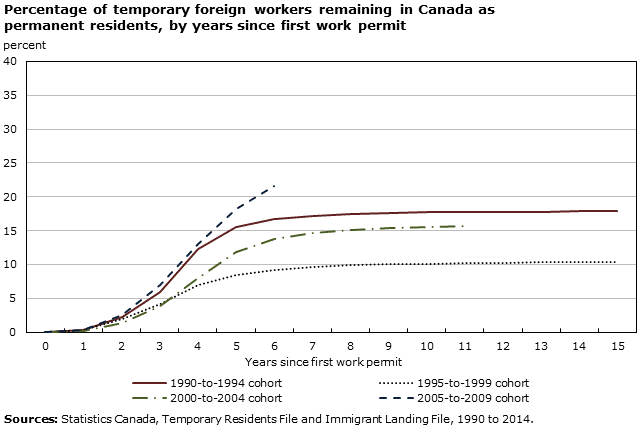Temporary foreign workers gaining permanent residence in Canada on the rise
A growing number of immigrants who come to Canada as temporary foreign workers are staying longer and obtaining permanent residence, a new report by Statistics Canada shows.
Entitled “Just how temporary are temporary foreign workers?”, the report looks at data for four cohorts of temporary foreign workers (TFWs) aged 18 to 64 who received a work permit between 1990 and 2009. Together, the cohorts represented more than 1.3 million work permit holders.
While the study’s findings suggest that the majority of of TFWs left within two years of obtaining their first work permit, it also notes that “the tendency to stay longer has increased among more recent arrivals.”
However, the study also concludes that the duration of stays remains strictly regulated, despite what it says is “a common misconception that host countries often do not have sufficient control over how long TFWs reside in the country.”
“The duration and type of stay of TFWs in Canada are strongly restricted by the regulations governing their work permit terms,” it reads.

In order to work in Canada as a TFW, a job offer is required. However, obtaining permanent residence is possible without a job offer, principally through Canada’s Express Entry system.
Policies helping TFWs transition to PR
The report studied TFWs who came to Canada through programs now grouped under the Temporary Foreign Worker Program (TFWP) and the International Mobility Program (IMP).
Examples of programs under the TFWP include the Seasonal Agricultural Workers Program, the Live-in Caregiver Program and the Low-Skill Pilot. Other TFWP participants are high-skilled professionals hired on short-term contracts.
The IMP is also composed of several different programs that mostly cover high-skilled professionals, including professionals working in Canada under international agreements like the North American Free Trade Agreement (NAFTA), on intra-company transfers and as research-and-studies-related work permit holders such as foreign medical interns.
The study considered four variables to see what, if any, impact they had on length of stay among TFWs in these two groups. These variables were individual demographic characteristics (age, sex), source-country economic and social conditions, host-country institutional factors, such as government regulations, and local and regional socio-economic conditions.
Host-country policies and regulations were found to be critical to the length and type of stay of TFWs, with the study noting that the lengthening stays among new arrivals beginning in the late 1990s was “consistent with Canada’s increased reliance on TFWs and the expanded pathways to permanent residence.”
Pathways to permanent residence
Yet not all TFW programs are alike when it comes to pathways to permanent residence. The study notes that such pathways tend to be more numerous for high-skilled temporary workers.
The study says this reflects the fact “Canada’s immigration selection system rewards candidates for human capital assets such as education, Canadian work experience and official language abilities.” To this end, certain work experience gained as a TFW in Canada can be counted toward a candidate’s eligibility under the Canadian Experience Class as well as towards their federal Express Entry Comprehensive Ranking System score. Such work experience is also favoured by a number of Provincial Nominee Programs, which allow Canada’s provinces and territories to nominate a set quota of immigrants each year.
Among TFWP streams, Live-in Caregiver Program participants have been able to apply for permanent residence after two years of full-time work in Canada, but the same option is not available for seasonal agricultural workers, who must leave the country after eight months. While the majority of LCP participants became permanent residents by their fifth year in Canada, only two per cent of SAWP participants had done so by their tenth year in Canada.
The study notes that the primary pathways to permanent residence for low-skilled workers are through provincial or territorial nomination programs, or PNPs, that respond to local labour needs.
Country of origin
Country of origin also plays a key role in determining how long TFWs stay in Canada, with those originating from countries with “lower levels of economic development and social stability” staying longer in Canada as temporary residents or becoming permanent residents than those from more prosperous, stable countries.
The study found that by the fifth year after their first work permit, 42.8 per cent of TFWs from countries with low Gross Domestic Product (GDP) per capita acquired permanent residence. By contrast, only 7.4 per cent of TFWs from countries with a high GDP per capita transitioned to permanent residence in Canada. Social stability also played a role in length of stay, with 37.9 per cent of TFWs from countries with low social stability gaining permanent resident status by their fifth year in Canada.
However, the study concluded that many source country differences were explained by the fact citizens of less developed and less stable countries were the main recipients of TFWs in the Live-in Caregiver Program (LCP), Seasonal Agricultural Workers Program (SIWP), and the Low-Skill Pilot (LSP).
“TFWs in all these programs had a high tendency to stay longer or come back after leaving for a few months,” the study says.
Individual characteristics, regional socio-economic conditions were found to have a “relatively weak” association with length of stay. That said, TFWs who arrived “at the prime working age (25 to 44)” had a higher tendency to stay as temporary or permanent residents than those on the younger or older end of the age spectrum.
The study found the share of TFWs who transitioned to permanent residence was highest between the second and fifth year after obtaining their first work permit.
“After the fifth year, the share of TFWs who became permanent residents surpassed the share of TFWs who remained temporary residents, in most cases,” the study observes. “By the 10th year, the remaining TFWs overwhelmingly comprised permanent residents.”
For more information on temporary work permits, please consult this page.
Have a Canadian job offer? If you have a job offer and would like assistance with the work permit process, please send CanadaVisa an email with a copy of your job offer to wp@canadavisa.com
Looking for a job in Canada? If you're looking for work in Canada, Canadavisa.com's free Job Search Tool pulls together current job postings and employer contact information from numerous Canadian government and private sector job search engines.
© 2018 CICNews All Rights Reserved
- Do you need Canadian immigration assistance? Contact the Contact Cohen Immigration Law firm by completing our form
- Send us your feedback or your non-legal assistance questions by emailing us at media@canadavisa.com






